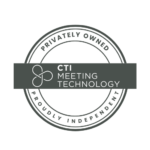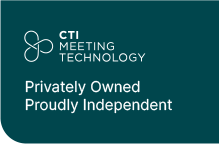Event organizers work in a fast-paced environment. With multiple changes happening and attendee expectations changing, there is no doubt that efficiency and organization are critical to success.
Whether hosting a large conference or a series of webinars, the technology solutions you use can make or break your event. In fact, event management software allows associations to streamline every aspect of meeting planning, reducing planning time and costs.
While the right tech can give you a huge leg up, that’s one small part of the roadmap to a successful meeting. Event associations must understand audience preferences, manage staff, promote the event, etc. Sounds like a lot? Then, keep reading.
In this guide, we will explore best practices for event associations, focusing on selecting the right management software, training your team, optimizing event planning, enhancing attendee experience, managing data, and streamlining marketing efforts. Follow these best practices, and we can guarantee that your association will deliver outstanding meetings.
Selecting the Right Management Software
The foundation of successful event management lies in correctly assessing your needs. What is your main goal with this event? Perhaps you want to gain new customers. Or host a conference around a specific topic. Whatever your goals are, this is the first step: defining why you are hosting an event in the first place. Once you have clearly established the event goals, you can start planning the type of event you will host. A small event, large conference, fundraiser, a series of webinars… the possibilities are endless.
The foundation of successful event management lies in choosing the right software solutions. Once you know why you are hosting an event and your meeting format, you can select the right tech for your needs. During the assessment, ask yourself the following questions:
- What type of events does your association typically organize?
- How many attendees do you usually expect?
- What kind of content do you focus on?
- Who is your audience?
Now that you understand your needs, it’s time to compare the features of different event management software solutions. Look for tools that offer a comprehensive suite of features, such as:
- Centralized Event Management: Manage all aspects of your event from a single platform, including submissions, scheduling, and communication.
- Automated Processes: The system can save time and reduce errors by handling email reminders, registration confirmations, post-event surveys, and other tasks.
- Real-Time Collaboration: This feature is essential for teams working remotely or across different locations. It enables seamless communication and collaboration among staff and volunteers.
- Data Management and Analytics: A good event management tool should offer robust data management capabilities, including analytics and reporting. This tool helps you track performance and make data-driven decisions.
Selecting the right vendor is just as important as choosing the right software. Research potential vendors thoroughly, considering their reputation in the market, customer support, pricing, and other factors. Consider the following when looking for vendors:
- Customer support: Responsive customer and client support are crucial to ensure a smooth meeting, including training and ongoing assistance.
- Pricing: Compare pricing models to ensure the solution fits within your budget. Be aware of any hidden fees or additional costs for features or support.
- Scalability: Choose a solution that can adapt as your association grows. This is particularly important if you anticipate an increase in the number or scale of your events.
Selecting a vendor is like buying a car. A reliable partner is an investment that will be a valuable asset for years to come!
Setting an Accurate Budget
According to this Skift Meetings survey, budgeting is one of the most challenging parts of event planning for organizers. Develop a detailed plan that serves your goals while also bringing enough ROI. Identify all potential expenses – venue rental, catering, marketing, speaker fees, and technology, to name a few – and constantly monitor expenditures to make any necessary adjustments.
Likewise, revenue tracking is just as important as managing expenses. Monitor your different sources of income to identify potential cash cows. Then, have your team prepare a comprehensive report after the event to identify areas that can be improved for future meetings.
Life happens, so include some extra budget for your contingency plan.
Comprehensive Training for Staff and Volunteers
Event management tools are only effective if your staff are using them correctly. Comprehensive training for all staff and volunteers is crucial to ensure everyone can use the software to its full potential.
Tutorials covering every aspect of the software are essential, as they can be tailored to different roles within your association, ensuring that every team understands the features that are relevant to their responsibilities. For example, staff responsible for presentation collection should be trained to manage uploads with multiple file versions and sync them to the correct session.
You can approach this initial training process in different ways: make one person in your team an expert in the software, who will then train the other staff, or you can assign the corresponding training courses to each staffer. Whatever you decide, having a provider that offers initial training programs makes this process way more digestible.
Some of the content offered in these programs can be:
- Interactive Tutorials: Hands-on training sessions where staff can practice using the software in a simulated environment.
- Role-Specific Modules: Training materials tailored to specific roles and responsibilities of your team members.
- Live Q&A Sessions: Opportunities for staff to ask questions and clarify any uncertainties about the software.
However, training shouldn’t stop after the initial implementation. The events industry – especially the tech – is ever-changing – at least if you want to work with a system that doesn’t grow outdated. Ongoing training and education are essential to keep your team up-to-date with the latest features and best practices.
Encourage your team to also participate in webinars, attend workshops, or take advantage of online resources provided by the software vendor. This approach ensures that your staff remains familiar with the tool and can take advantage of new features as soon as they are available. An open support channel where you and your team can ask the software provider questions about the tools used is also a way to ensure you’re using event technology correctly.
Optimizing Event Planning and Management
We mentioned that one of the must-have features of using event technology is having a centralized platform that allows you to manage all aspects of the meeting from a single place, including submission, reviewing, communication, and analytics. This streamlined approach reduces the risk of manual errors, saves your team valuable time, and improves overall efficiency.
With centralized meeting management, you can:
- Oversee Processes Seamlessly: Monitor all the processes from the platform and clearly identify which areas need more staff or work assigned.
- Maintain Consistent Communication: Making all team members, volunteers, and stakeholders use the same platform means that they have access to the same information, reducing the likelihood of miscommunication.
- Easily Track Progress: Use dashboards and reporting tools to monitor the status of various event components, such as registration details, email campaigns, and submission tracking.
Your association can also save valuable time by automating repetitive tasks, such as sending email reminders or generating reports. Automated processes also allow your team to focus on more pressing tasks. For example, you can exchange the time it takes to manually send hundreds of emails to improve your promotional strategies and increase attendance.
There are many ways in which automation can be used. And even though it might seem tempting to let software take care of everything, many tasks benefit from a human touch. Take care when choosing where to focus your energy and time!
Using a unified platform also offers an advantage for remote teams. Now more than ever, organizations need ways to work together efficiently as a team, regardless of their location. By leveraging a 360º platform and automated processes, your association can ensure that all aspects of event planning are coordinated smoothly, leading to more successful events.
Enhancing Attendee Experience
According to Bizzabo, 91% of attendees appreciate having a personalized event experience. Enhancing the attendee experience is a top priority for organizers, and one of the most effective ways to do this is through personalized communication.
While organizing your data and sending personalized messages to your audience might be time-consuming to do manually, event management software can help execute this best practice. By segmenting your audience based on registration data, location, or job, your staff can send targeted messages that resonate with each segment. These include, but are not limited to:
- Personalized invitations and registration reminders.
- Name badges.
- Personalized itinerary and schedule.
- Thank-you email and survey after the event.
Including personalization in your event enhances the attendee experience and increases the probability of repeat attendance and positive word-of-mouth recommendations.
Integrating Interactive Features
Other tools that can help keep attendees engaged and make your event more memorable are interactive functionalities. They should also provide valuable data on attendee preferences and behavior, which your team can use to improve future events. Consider integrating these into your meetings:
- Live Polls and Q&A Sessions: Encourage attendee participation during sessions by enabling live polls or Q&A sessions where attendees can ask questions in real time.
- Networking Opportunities: Use networking tools to connect attendees with similar interests or professional backgrounds, facilitating meaningful connections.
- Polling: Gauge your attendees’ knowledge on a topic or get insights into their preferences by incorporating polling during the sessions.
- Gamification: Add a fun and competitive element to your event by incorporating gamification features, such as leaderboards, challenges, or scavenger hunts.
Collecting feedback is also a best practice you should implement at the end of your meetings. This step is essential for understanding audience satisfaction and identifying areas of improvement. The easiest way to do it is by scheduling a feedback email that can be sent from the event platform as soon as the meeting is over. Make sure to ask concrete questions. Do not be afraid of criticism; this is some of the most valuable data you can get! Read our list of questions you should ask after each event if you need inspiration.
Leveraging Data Management and Analytics
Analytics and reporting tools are essential for measuring the success of your events and making data-driven decisions. Managing your meetings from a unified platform means that you can gather insights from every part of the event. Organizers can use analytics to:
- Measure Event Performance: Analyze registration trends, attendance rates, and session popularity to determine the most successful aspects of your event.
- Identify Areas for Improvement: Use data to identify any issues or areas where performance fell short, such as low engagement in certain sessions or marketing campaigns that didn’t convert.
- Identify Trends: Track audience behavior to identify common patterns.
- Plan Future Events: Leverage insights from past events to inform your planning for future events, ensuring that each event is better than the last.
Managing Data and Ensuring Privacy
You and your team handle lots of personal data. Full names, email addresses, and even personal addresses might be some information stored on the event platform, so ensuring data security and compliance is paramount. Your event software should include robust security features and follow data protection regulations such as GDPR. But it’s also your job to safeguard this valuable data within your association. Here are a few measures you can implement:
- Establish Access Controls: Limit access to sensitive data to authorized personnel only, using role-based permissions.
- Encrypt Data: Ensure that all data stored within the software is encrypted to prevent unauthorized access.
- Stay Compliant: Regularly review your data management practices to ensure they comply with applicable regulations, and work with your software vendor to implement necessary security updates.
Prioritizing data security is crucial to building trust with attendees and other stakeholders, plus protecting your organization from any potential legal risks.
Event Marketing and Promotion
Effectively using event software and other best practices is key to delivering a successful meeting to your audience. However, none of this matters if your target audience has no idea about your upcoming event!
Your marketing team should research and find out the best way to promote your event, but here are a few strategies that you can implement directly from the event management platform:
- Create Targeted Campaigns: Segment your audience based on registration data, past event attendance, or other criteria, and create tailored marketing campaigns that resonate with each segment.
- Monitor Campaign Performance: Track the success of your marketing efforts in real time, using metrics such as email open rates, click-through rates, and social media engagement.
- Automate Promotions: Use automation to schedule and send marketing materials at optimal times, ensuring maximum reach and engagement.
Targeted marketing campaigns are more likely to resonate with your audience and drive registrations. When you open your email inbox in the morning, which emails take preference? Emails directly addressed to you or generic messages with clear promotional goals?
While you should remember the goal of sending out a targeted email campaign is to promote your event and get more registrations, adding a personal touch will bring better results. Simple things like including the recipient’s name and segmenting your campaigns by role and location can highly impact your opening rates.
A lot of things in marketing are trial and error. Don’t be afraid to continuously track email performance and apply any adjustments that might be necessary. Use these insights to refine your marketing strategies for future events, ensuring effective campaigns.
Read more tips about how to effectively promote your meeting.
Wrapping Up…
By integrating these best practices into your event management strategy, you’ll improve efficiency and effectiveness while creating memorable experiences that keep attendees coming back.
CTI Meeting Technology has all the features you need to make your events successful. Explore our solutions for associations today, or schedule a free demo.





